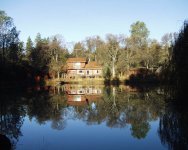Bob,
A few thoughts on your pond questions, based on our experience with a new 3/4 ac., 12' deep pond which was put in two years ago to replace a smaller century-old livestock pond which was mucked in 'til it was only about 3' deep and had trees growing all over the dam. Having a bunch of water in the yard is a wonderful thing.
As far as engineers, etc. go, we had the good fortune to find a guy who had done about nothing but build ponds since he was 12 years old working for his uncle. Our county extension service representatives came out, met with him, looked at the test holes he dug with his 'hoe, and told me I didn't need any engineer because he knew what he was doing. He worked with no drawings and didn't even use a transit for the first 10 days. Where we are, no permits were required for pond construction; he just came out and got started.
What he did could no way be done with a compact tractor--or any other tractor--in a reasonable time. He used a trackhoe, a D9 dozer, and a sheepsfoot compactor. We are fortunate (as far as ponds go, anyway--not all good for gardens) to have dense clay soil, but he still went down to bedrock--through it by 10' for the dam--and then compacted a foot or two of clay at a time to build back up the sides of the pond. I gather you're thinking about a pond which is fed by the water table, which is a different animal from ours which is all rainwater. The place looked like a bomb went off for a few days, but the whole project, which included lowering the entire pond level by 10' and recontouring about 2 1/2 acres to provide optimal runoff, took 21 days.
I've read through these posts and everything Fishman said is consistent with what I've learned, including the part about grass carp (white Amur) NOT being a satisfactory antidote to algae; in fact, they don't seem to even touch it. They also will come out of the water onto shore--fact--to eat ornamental plants you've put near the water. I put in five 12" Amur based on what I think was a bogus recommendation and they are now more than double that size. They can grow to 60-80 lbs., and are about impossible to catch except bow hunting; not having a bow I'm currently trying to kill them with a .223 varmit gun. Copper sulfate works extremely well to control algae, but I use a pond-store product called Cutrine, another copper product which when diluted and sprayed on algae kills almost on contact without any adverse impact on the water quality, fish, etc. I guess it is "chemicals" in the sense that it is adding something to the water that isn't there, but it is not harmful to anything, so far as I know, but the algae. The only downside I've ever read or heard is that over many years the and/or the dead algae will build up on the bottom and adversely affect the dissolved oxygen levels in the pond.
We had a bad algae bloom last spring, I think in part because I made the mistake of fertilizing the grass in the watershed; of course a lot of that ran into the pond. We swim and boat in the pond and so algae control is pretty important to us. I do this with a bottom aerator which runs two hours morning and night, and with a waterfall. Last summer I added beneficial bacteria a few times, which you can read about
Aquamats, which are an engineered fiber "reef." These things are expensive and I've put in half what they recommend but they do seem to be making a difference (and have a one-year money-back guarantee). I also don't hesitate to spray with Cutrine if there is a bloom I want to control in a hurry.
It all seems to be working. This spring we have enough algae on the margin to give the small fry a place to hide, but no nasty filamentous mat on the bottom (at least, not yet; it's still early) and nothing spreading out beyond the shore line.
Good luck!


